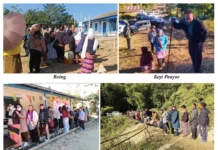[ Anupam Rohit ]
As the festive season approaches, with Christmas and New Year celebrations just round the corner, it’s important to address a growing concern in Arunachal Pradesh – substance abuse in the name of festivity.
While the state is known for its vibrant culture and spirited celebrations, the data from the National Survey on the Pattern and Extent of Substance Use in India (2019) paints a sobering picture of drug and alcohol abuse, with devastating consequences for public health.
Substance use in Arunachal
Arunachal ranks alarmingly high in the consumption of various substances. According to the survey, alcohol use in Arunachal stands at 28%, almost double the national average of 14.6%, placing it 4th among all states and union territories.
Opioids are used by 22.18% of the population, the second highest in the country, compared to the national average of 2.06%.
Cannabis use is at 7.36%, significantly above the national average of 2.83%. Even substances like cocaine and amphetamine-type stimulants (ATS), which are considered niche drugs, see usage rates of 3.01% and 3.8%, respectively – again much higher than the national averages.
Moreover, inhalant use among young people (10 to 17 years old) in Arunachal is disturbingly high, with current use reported at 8.65%, compared to 1.17% nationally. This indicates an alarming trend of substance experimentation among adolescents.
Health implications
One of the most concerning repercussions of drug abuse is the rise in infectious diseases such as HIV, Hepatitis B, and Hepatitis C. With over 8,580 people in Arunachal estimated to inject drugs, unsafe injecting practices are a significant driver of these infections. Shared needles and lack of access to harm- reduction services amplify the spread of these viral diseases.
Globally, injection drug use accounts for nearly 10% of new HIV infections, and Arunachal is no exception. Hepatitis C, a silent but deadly viral disease, is also spreading rapidly among people who inject drugs, leading to chronic liver conditions that may go unnoticed until it’s too late.
Festivities and risk amplification
Festive seasons often bring a surge in substance use as people celebrate without recognising the associated risks. Social gatherings, increased access to alcohol, and a cultural leniency towards drug experimentation during festivities further exacerbate the issue. For many, this is also a time of emotional vulnerability, leading to increased reliance on substances as coping mechanisms.
A call to action
It is crucial to address this growing epidemic with urgency and compassion. As we embrace the spirit of Christmas and New Year, let us also remember the importance of protecting lives. Here are some steps we must take:
Awareness campaigns: Educate communities about the risks of substance abuse, particularly during festive seasons.
Harm reduction services: Ensure access to needle exchange programmes, opioid substitution therapy, and overdose prevention programmes.
Counselling and rehabilitation: Strengthen support systems for those battling addiction.
Youth engagement: Introduce programmes aimed at preventing substance abuse among adolescents.
This festive season, let us celebrate responsibly and work towards a healthier Arunachal. It’s time we confronted the realities of substance abuse and its impact on public health, creating a future where celebrations don’t come at the cost of lives. (The writer is project head, Recovery Wellness Society.)



